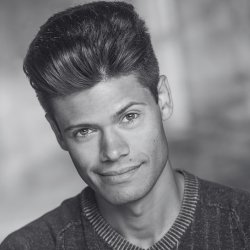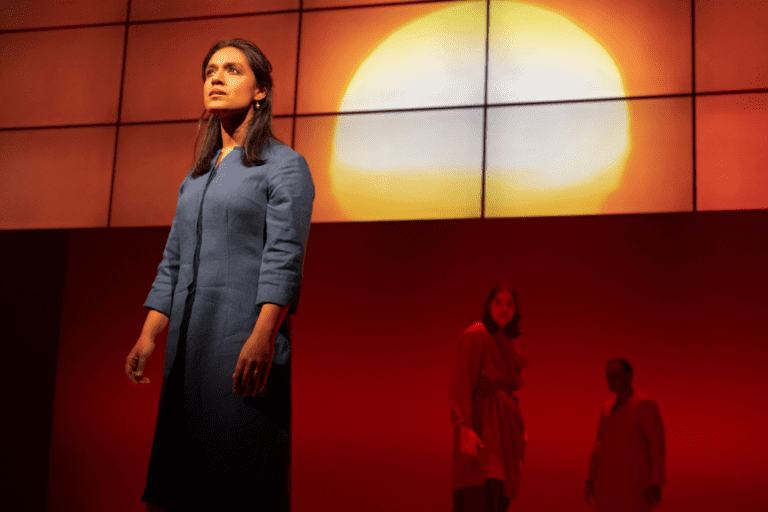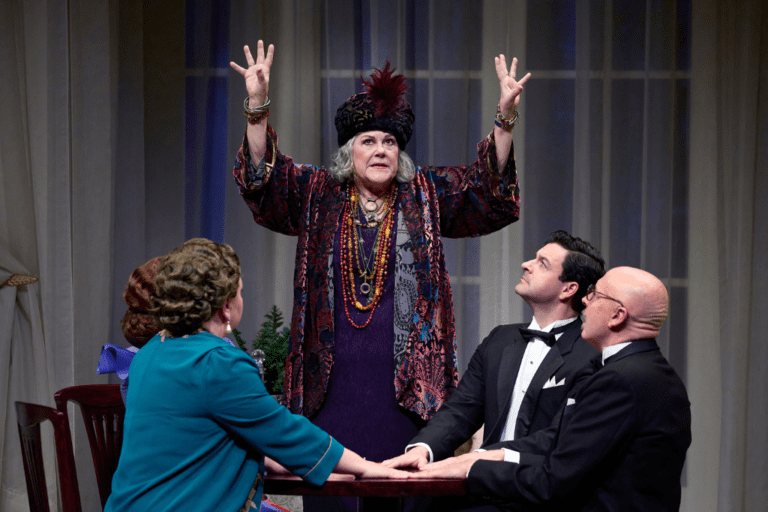Santee Smith’s SKéN:NEN carries her culture beyond apocalypse
Kahnyen’kehàka artist Santee Smith’s work has always been a vessel: a way of holding her family, her nation, and their stories close. Now, Smith is carrying that vessel into the future — and beyond apocalypse.
SKéN:NEN, the newest work from Smith’s company’s Kaha:wi Dance Theatre, fuses movement, narrative, music, and ambitious projection design to tell the story of a young Kahnyen’kehàka woman, Niyoh (short for Strawberry in Kanyen’kéha), who flees her home of Six Nations after a climate catastrophe in the year 2050. Niyoh finds her way to her ancestral Kahnyen’kehàka homeland in the Adirondack Mountains, where she joins a bunker camp and becomes part of an emerging community seeking skén:nen — the Kanyen’kéha word for balance.
Presented by TO Live, SKéN:NEN plays at the Bluma Appel Theatre on May 10 and 11. The piece is the third installment in a dance-theatre triptych by Smith. Requickening, the first part of the triptych, premiered at the Harbourfront Centre in 2016; Blood Tides, the second part, premiered in 2018 at FirstON Performing Arts Centre. “What I wanted to achieve through the triptych was to tell stories from Indigenous women’s perspective,” said Smith, who spoke to me over Zoom from her home in Six Nations. “That is also to deal with what [the word] skén:nen means. Every ceremony, every song that we have, every way that we do planting cycles, how we address the body through different practices, has to do with maintaining balance.”
The balance Smith articulates in the triptych restores “the importance and the prestige that women had in equality, pre-contact,” the artist told me. “That was the very first thing that was destroyed [by colonization].” Smith first began work on the triptych in 2014, and collaboration with other Indigenous women has been central from the start. “I invited Christi Belcourt, Francis Rings, Leanne [Betasamosake] Simpson, [and Monique Mojica] for a weekend of conversation at Six Nations,” Smith remembered. “We just sat around the table talking about all the themes that I was interested in. All of them are artists, and listening to what they had to say in casual conversations was part of that initial foundation of the work.”
At the core of SKéN:NEN’s vision of balance is the Haudenosaunee concept of The Great Good. “The Great Good is the foundational remembering of how to live in balance,” said Smith. “A lot of the time, if you Google it, [the translation comes up as] great law — but it’s not really law. Law implies something that’s man-made. [The Great Good is] not a code. It’s a way of being in the world: a way, a perspective, a framework…. Everything has to do with the workings of nature, and nature as guide.”
Not only is Smith the director and choreographer of SKéN:NEN, she’s a performer in the piece and the lead designer. In part, the decision to wear so many hats stems from Smith’s sense of cultural responsibility — and specificity.
In SKéN:NEN’s projection design, “Anything that [looks] traditional, I drew,” said Smith. “Then it gets turned into an animation.” Smith gave the example of a white pine design, an important symbol for the Haudenosaunee Confederacy of which the Kahnyen’kehàka are a part.
“I could say, ‘I need a tree’” Smith continued, “but [a non-Haudenosaunee designer] wouldn’t know that the four roots [of the pine] are important. You have to have the four roots.”
Traditional Haudenosaunee buildings that appear in the video design for the piece aren’t computer generated; they are real structures that Smith and her dancers built, both in her “traditional homelands in upstate New York” and near Smith’s home in Six Nations. “Part of the process is, you’re out there gathering sticks and you’re making a lodge from scratch,” Smith said. “The dancers have to be part of that process. They have to be able to know what it means to dance and move on the earth, or climb over a log, or get caught up in a bush.”
Smith’s multidisciplinary approach to creation isn’t just about cultural specificity; it’s also family legacy. “I come from a family of artists,” Smith told me. Smith’s daughter, Semiah, is one of the singer-songwriters and video dancers in SKéN:NEN. Smith’s grandmother Elda “Bun” Smith was “crazy creative: She made cabinets, she collected and sold antiques, she created leather jackets that movie stars wore,” said Smith. She credits her grandmother as the first person to encourage her love for dance. “She was ill with rheumatoid arthritis,” Smith said. “So she would just sit and watch me for hours dancing for her. She would say — and of course people are telling me this because I don’t remember — that I was her medicine.”
Elda “Bun” Smith is most well-known for reviving a tradition of Haudenosaunee pottery. “She gifted a piece of pottery to Queen Elizabeth at Expo [67],” Smith told me. She explained that her grandmother incorporated wampum belt designs into the pottery, as “a reminder of the relationship of the Haudenosaunee people to the crown, as nation-to-nation, and to remind [the Queen] of our agreements.”
It’s fitting then, that when Smith and dramaturg Monique Mojica began to search for an overarching model for the triptych, they landed on pottery. “Pottery became our dramaturgical model,” Smith told me. “[It] features in every part of the triptych. The vessel became a symbol of a woman’s body when it is buried or fractured or broken, [as well as a symbol for] putting the pieces back together — or witnessing a shard and imagining the whole.” That broken vessel made whole is also a metaphor for collaboration, Smith said: “One person has a shard of knowledge, and [another] person has a shard of knowledge — what happens when you bring them together?”
SKéN:NEN features projections of pottery made by Smith’s father, Steve Smith, as well as wampum belt designs drawn by Smith herself: an echo of her grandmother’s gift to the Queen. “Different form, same message,” Smith reflected. “A reminder of our agreements, not only with nations but with the Earth, [and a reminder of] the importance of women. I always say I’m a continuation of my ancestor’s creativity. I’m just the next generation that’s carrying things forward and doing things in different ways.”
SKéN:NEN runs May 10 and 11 at the Bluma Appel Theatre. Tickets are available here.












Comments